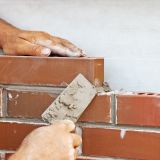Intermediate:
\n- Engineering, Building, and Safety Codes II
\n- Grout
\n- Job Layout
\n- Masonry Unit Preparation II
\n- Materials and Safety Equipment
\n- Mortar II
\n- Structural Masonry
\n- Non-structural Masonry
\n- Temporary Masonry Supports
\n- Tools and Equipment
\n- Wall Systems Accessories II\n- Waterproof Below Grade \n
Advanced:
\n- Building Equipment Contractors
\n- Use of Material, Tools, and Equipment
\n- Use of Material Handling and Safety Equipment
\n- Engineering, Building, and Safety Codes III
\n- Temporary Masonry Supports II
\n- Wall Systems Accessories III
\n- Mortar III
\n- Masonry Unit Preparation III
\n- Job Layout II
\n- Structural Masonry III
\n- Non-structural Masonry
\n- Fireplace and Chimney
\n- Restoration Masonry
", "display_order": 2, "created_at": "2019-10-01T11:36:12.619082-07:00", "updated_at": "2022-01-26T11:58:50.422381-08:00"}, {"degree_id": 1141, "page": 1, "title": "Degrees Similar to Masonry", "summary_markdown": "**[Building Inspection](/degrees/building-inspection-degree/)** \r\nPrograms in building inspection teach students the skills needed to examine structures and verify that they have been constructed according to building codes and other related laws and regulations. \r\n\r\n**[Carpentry](/degrees/carpentry-degree/)** \r\nCarpentry training programs teach the skilled trade of cutting, shaping, and assembling wood for buildings and other structures. Students of the trade learn about the two basic types of carpentry: rough carpentry and finish carpentry. \r\n\r\n**Other Construction Trades** \r\nThese trades include drywalling, tile and marble setting, carpet laying, glazing (glass installation), insulation, and ironwork,", "content_markdown": "**[Civil Engineering](/degrees/civil-engineering-degree/)** \r\nCivil engineering students learn how to design and plan civil infrastructure like roads, tunnels, bridges, dams, railroads, and airports. Classes include math, statistics, engineering systems and mechanics, and building codes. \r\n\r\n**Engineering Technology** \r\nEngineering technology programs teach the engineering skills required to assist engineers in their work. Common classes are computers for engineering technology, construction methodologies, structural systems, strength of materials, and technical drawing. Some of the subfields of engineering technology are civil engineering technology, construction engineering technology, aerospace engineering technology, and automotive engineering technology. \r\n\r\n**[Welding](/degrees/welding-degree/)** \r\nWelding students learn the process of joining metals using extreme heat. They study metallurgy, the properties of different types of metals, and different types of welding.", "content_html": "
Civil Engineering
\nCivil engineering students learn how to design and plan civil infrastructure like roads, tunnels, bridges, dams, railroads, and airports. Classes include math, statistics, engineering systems and mechanics, and building codes.
\n
Engineering Technology
\nEngineering technology programs teach the engineering skills required to assist engineers in their work. Common classes are computers for engineering technology, construction methodologies, structural systems, strength of materials, and technical drawing. Some of the subfields of engineering technology are civil engineering technology, construction engineering technology, aerospace engineering technology, and automotive engineering technology.
\n
Welding
\nWelding students learn the process of joining metals using extreme heat. They study metallurgy, the properties of different types of metals, and different types of welding.
", "display_order": 3, "created_at": "2019-10-01T11:36:12.620164-07:00", "updated_at": "2022-01-26T11:59:53.633772-08:00"}, {"degree_id": 1141, "page": 1, "title": "Skills You’ll Learn", "summary_markdown": "After completing their studies and apprenticeship, masonry grads are equipped with these transferable skills: \r\n\r\n**Physical Strength and Stamina** \r\nThis is physical work that calls for physical strength and stamina. \r\n\r\n**Eye for Detail** \r\nThe work requires attention to specifications and precise measurements. \r\n\r\n**Color Vision** \r\nSome of the work that masons do, such as setting terrazzo patterns, requires that they are able to distinguish between subtle color variations. \r\n\r\n**Critical Thinking and Troubleshooting Abilities** \r\nWhen they encounter problems, masons must be able to think quickly and critically to come up with solutions. \r\n\r\n**Math Skills** \r\nMath skills are needed to interpret blueprints and calculate sizes, distances, and quantities of material. \r\n\r\n**Hand-Eye Coordination / Manual Dexterity** \r\nStudents who study masonry must learn how to apply smooth and even layers of cement to set bricks. \r\n\r\n**Communication Skills** \r\nClear communication with clients and colleagues is essential to the smooth operation of a project.", "content_markdown": "", "content_html": "
After completing their studies and apprenticeship, masonry grads are equipped with these transferable skills:
\n
Physical Strength and Stamina
\nThis is physical work that calls for physical strength and stamina.
\n
Eye for Detail
\nThe work requires attention to specifications and precise measurements.
\n
Color Vision
\nSome of the work that masons do, such as setting terrazzo patterns, requires that they are able to distinguish between subtle color variations.
\n
Critical Thinking and Troubleshooting Abilities
\nWhen they encounter problems, masons must be able to think quickly and critically to come up with solutions.
\n
Math Skills
\nMath skills are needed to interpret blueprints and calculate sizes, distances, and quantities of material.
\n
Hand-Eye Coordination / Manual Dexterity
\nStudents who study masonry must learn how to apply smooth and even layers of cement to set bricks.
\n
Communication Skills
\nClear communication with clients and colleagues is essential to the smooth operation of a project.
", "display_order": 4, "created_at": "2019-10-01T11:36:12.621489-07:00", "updated_at": "2021-11-18T13:55:44.001848-08:00"}, {"degree_id": 1141, "page": 1, "title": "What Can You Do with a Masonry Degree?", "summary_markdown": "As masonry is a very specific trade, those trained in it typically work directly in the field. The largest employers of masons are poured concrete foundation and structure contractors and masonry contractors. Masons also find employment with commercial and residential construction companies, as well as with heavy and civil engineering construction firms. Some are self-employed. \r\n\r\nWithin each of these employment sectors, they lay and finish concrete for other construction trades, including [carpenters](/careers/carpenter/), floor and carpet layers, tile setters, [glaziers](/careers/glazier/), pavers, floor sanders, sheet [metal workers](/careers/metal-worker/), boilermakers, fireplace installers, and landscapers.", "content_markdown": "", "content_html": "
As masonry is a very specific trade, those trained in it typically work directly in the field. The largest employers of masons are poured concrete foundation and structure contractors and masonry contractors. Masons also find employment with commercial and residential construction companies, as well as with heavy and civil engineering construction firms. Some are self-employed.
\n
Within each of these employment sectors, they lay and finish concrete for other construction trades, including carpenters, floor and carpet layers, tile setters, glaziers, pavers, floor sanders, sheet metal workers, boilermakers, fireplace installers, and landscapers.
", "display_order": 5, "created_at": "2019-10-01T11:36:12.622574-07:00", "updated_at": "2021-11-18T13:55:44.002925-08:00"}], "degree_specializations": []}">

